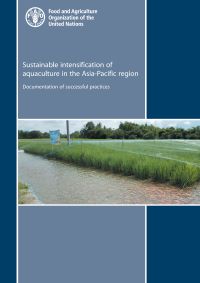Aquaculture sustainability: Towards 2030
4 March 2013 | Rohana Subasinghe | 5537 views | .mp4 | 36.85 MB | Food Security, Safety and Certification, Environment and Sustainability
Just twelve years ago, there were six billion people on this planet. Now we are seven billion, and according to estimates of the United Nations, global population will reach 9.3 billion by 2050 and exceed 10 billion by the end of the century. With hunger and malnutrition identified as a devastating problem facing the world’s poor, the challenge governments and international development communities need to address, given the steep population growth, will be to ensure adequate food for all. To provide food to the world’s population in 2050, it has been estimated that agricultural output, primarily from crops, livestock and fisheries, including aquaculture, must increase by 60 percent.
Meeting this target is indeed a formidable challenge for the international community, considering that an alarming number of people still suffer from hunger and poverty. Hence, finding opportunities to alleviate poverty and increase food security through agriculture, including fisheries and aquaculture, is vital and timely. Although the future forecasts look grim for global food production, the contribution of fish to global diets has now reached a record of about 17.6 kg per person on average, supplying over three billion people with at least 15 percent of their average animal protein intake. It has been estimated that in 2012, the annual per capita fish consumption will be around 19.2 kg.
In the annual State of World Population Report 2010, the United Nations Population Fund (UNFPA) has challenged the international development community that instead of asking questions like, “Are we too many?” we should instead be asking, “What can I do to make our world better?”. International development agencies could provide leadership and more assistance to increase production through expansion and sustainable intensification of the aquaculture sector, which will ease the formidable demand for global animal proteins in the coming decades. (Dr Babatunde Osotimehin, Executive Director, UNFPA, State of World Population Report 2010).
What made aquaculture the world’s fastest growing food industry? Several key factors have helped drive growth in the aquaculture sector. These key drivers include the fast growing market demand at local, regional and global levels, improvements in infrastructure, transport, processing and logistics, technical, human and institutional capacity, as well as new investment. The availability of natural resources and the social contribution of the industry, in poverty alleviation, employment generation and food security, have also contributed to aquaculture’s rapid growth.
Since the mid 1990s, aquaculture has increasingly driven growth in world fish production as global capture production has leveled off. Aquaculture’s contribution to total world fish production has climbed steadily from 20.9 percent in 1995 to 40.3 percent in 2010. By 2030, aquaculture production is projected at 211 million tonnes, representing a share of 58 percent of total supply. Will the supply be enough to feed future population?
Given that population growth is highest in Asia and Africa, where per capita fish consumption is lower than other regions, world per capita fish demand is projected to decline from 17.8 kg in 2007 to 16.6 kg in 2030 even if every country maintains its per capita consumption at the 2007 baseline level. Nevertheless, the fish supply-demand gap is estimated at 51 milllion tonnes by 2030, with the largest gap in Asia (29.8 million tonnes).
These projections indicate a clear need for a larger supply of fish to feed the growing population, but in reality, the aquaculture sector growth rate is slowly declining. How will humanity bridge the supply-demand gaps?
In order to stimulate growth in the aquaculture sector, formidable challenges must be overcome, including land and water resource availability, cost and energy efficiency, ecosystem impacts, continuing dependence of feeds on fishmeal and fish oil, biosecurity and health, environmental policy, technological advancement and the investment climate. Cost- and energy-efficient production systems will be essential to a robust aquaculture sector, and use of renewable energy and low carbon emission systems will become increasingly critical to sector sustainability. Among these, supply of feed is likely to represent one of the most important constraints, with fishmeal and fish oil considered crucial sources of both energy and essential fatty acids in aquaculture feeds. Major research efforts are under way to reduce the level of fish meal and fish oil in feeds and find alternatives to fish and fish oil in aquaculture, thus reducing the industry’s dependence on marine resources.
Revenues lost due to diseases in aquaculture are estimated to be in the range of US$5-6 billion per year. With increasing frequency of epizootics and emerging diseases around the world during recent years, improved surveillance and health management in aquaculture at all levels are, therefore, urgently needed. Increasing biosecurit y, appropriate biotechnology and breeding of resistant strains, strengthening national veterinary and quarantine capacity all need to be undertaken at both national and regional levels, in order to prevent transboundary transmission of pathogens.
Other areas requiring critical action to enhance sustainability of aquaculture include the need to ensure equitable distribution and hunger reduction; improving efficiency in small-scale aquaculture and empowering small holders, increased production of non-fed species for food security and fed species for income generation, and development of new species with superior qualities and/or consumer acceptability of GMO fish.
Despite these numerous and critical challenges, intensification of aquaculture is inevitable in the face of increasing demand, limited land areas, and improved technology. Whether we are able to accomplish this in a sustainable manner will depend on global governance and stewardship as much as on technological progress.
Creative Commons Attribution.
